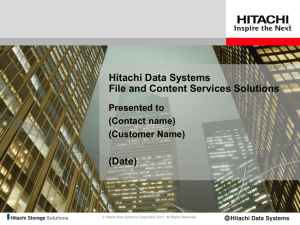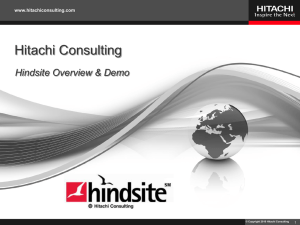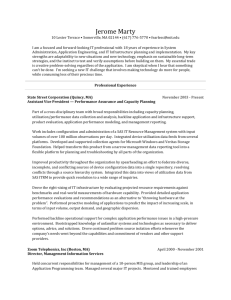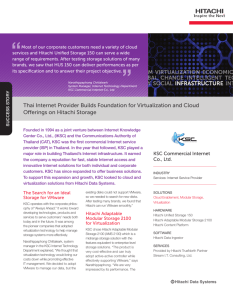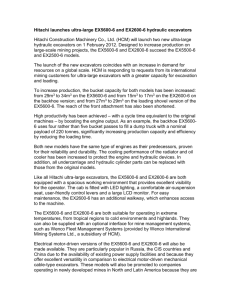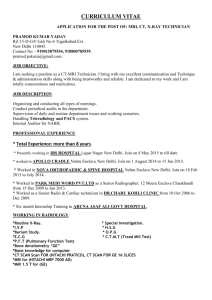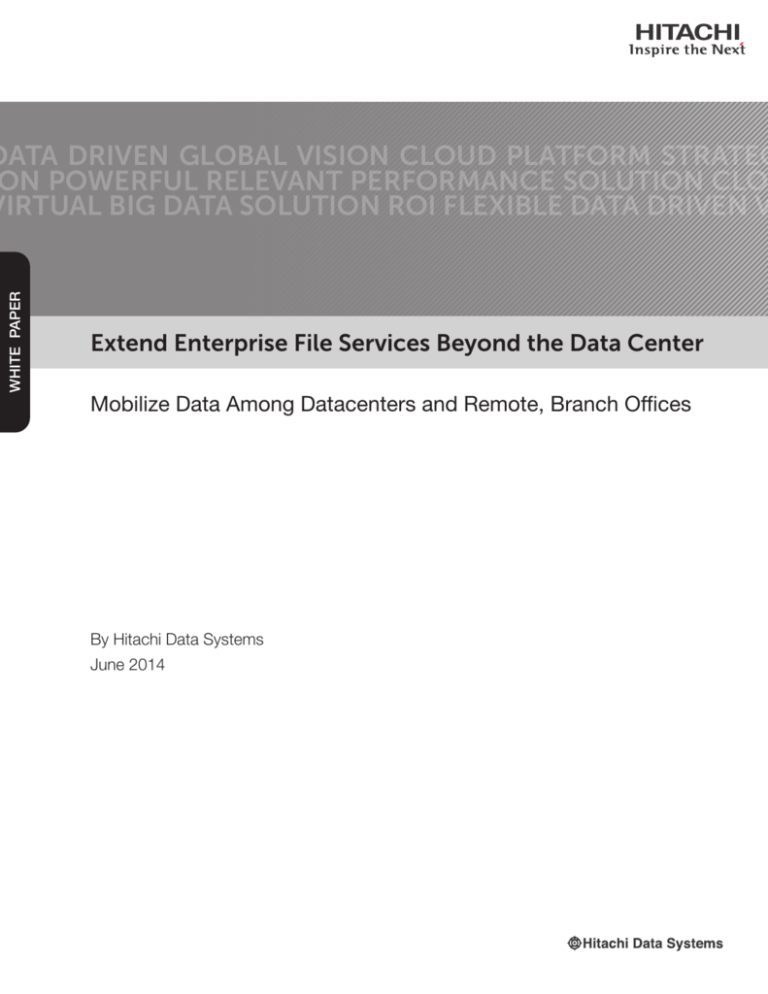
WHITE PAPER
DATA DRIVEN GLOBAL VISION CLOUD PLATFORM STRATEG
ON POWERFUL RELEVANT PERFORMANCE SOLUTION CLO
VIRTUAL BIG DATA SOLUTION ROI FLEXIBLE DATA DRIVEN V
Extend Enterprise File Services Beyond the Data Center
Mobilize Data Among Datacenters and Remote, Branch Offices
By Hitachi Data Systems
June 2014
WHITE PAPER
2
Contents
Executive Summary
3
Introduction
4
Challenges With Distributed IT Environments
4
Mobilize Data With Object Storage
7
Key Terms
8
Hitachi Data Mobility Solution
9
Welcome to the Edge: Hitachi Data Ingestor
11
Why Not Just Use NAS?
16
At the Core: Hitachi Content Platform
16
Tap Into Tangible Benefits
18
The Silver Lining for Cloud Deployments
19
No Longer "Out on a Limb" for Branch and Remote Offices
19
Shrink Tape-Based Dependencies and Costs
19
Gain Control Over Unstructured, Unruly Content
19
Simplify Storage Management and Savings
20
On the Horizon of Change
20
WHITE PAPER
3
Extend Enterprise File Services Beyond the Data Center
Executive Summary
Among today's most urgent IT challenges are the rampant growth of unstructured content and the need to reduce
the costs, complexities and risks associated with it. Particularly tricky is the management and proper handling of this
content across distributed IT environments, such as cloud service providers and organizations with branch or remote
office sites. Distributed IT environments are often saddled with sprawling storage silos for a multitude of applications
and workloads. They suffer from a buildup of backup infrastructure, and they have inadequate IT resources and safeguards at many locations outside the data center.
Hitachi Data Systems is focused on simplifying and accelerating cloud and other distributed IT environments to provide data mobility, content security and cost optimization.
Hitachi uses a proven and integrated approach to manage distributed IT environments and the flood of storage
requirements for unstructured content. We help cloud service providers and enterprise customers more easily provide
storage services to geographically dispersed users.
This paper examines how the Hitachi data mobility solution can decipher the challenges associated with managing
unstructured content for distributed IT environments. With Hitachi Data Ingestor at the edge and Hitachi Content
Platform at the core, this integrated, next-generation file services solution extends IT resources beyond the data
center. It addresses storage management, backup, archiving, compliance, content control and other key issues
facing distributed organizations and cloud storage service providers.
WHITE PAPER
4
Introduction
As stored data grows, so does the urgency to better control, protect, manage and preserve it. With the amount of
both structured and unstructured data reaching colossal proportions, IT leaders are probing for serious solutions
to mitigate costs, complexities and risks often inherent in the modern data center. In particular, unstructured data,
including documents, files, images and other content that cannot be defined in terms of rows and columns or standard structure, has given rise to a new set of challenges for IT. The proliferation of unstructured data growth and
increasing variation in data types continues to accelerate, leading to the spread of unplanned storage, which ultimately drives up operating expenses, capital expenses, management complexity and risk.
Beyond the types of data vying for storage are the matters of extensive scalability and concurrency: How do we keep
things coherent while scaling? The reality of manageable data storage remains elusive to many enterprise IT organizations, especially when hundreds of millions of objects must be stored and readily accessible for varying or indefinite
periods of time.
Compounded by the emergence of more distributed IT environments, such as remote or branch offices and cloud
deployments, the challenges within IT might seem insurmountable. Rather than continually bolting on more capacity,
the time has come to change how content is stored and managed.
Hitachi Data Systems has been integrally involved with solving these complex issues on behalf of its enterprise customers. For organizations with branch offices or remote locations and for cloud service providers whose consumers
are remote by the nature of the business, integrated Hitachi data mobility solutions are the answer. These solutions
help to seamlessly and securely move data between distributed locations and a centralized infrastructure. The results
are greater cost efficiency and reduced IT footprint at the remote or branch sites, and better control, security and
data protection for consumers of cloud services.
Challenges With Distributed IT Environments
For IT, the ability to store and protect company data at one location can be a daunting task. With multiple sites, the
challenge of storing, securing and appropriately managing data storage becomes exponentially more difficult (see
Figure 1). To better comprehend how to address these data management issues in distributed IT environments, it is
wise to first understand why these issues exist. And for purposes of this examination, Hitachi defines distributed IT
environments as:
■■
■■
Remote or branch offices (ROBOs). Remote or satellite offices are usually leased offices in a commercial building.
They provide professional office space in locations that are near where employees live, to cut down on commuting
while still ensuring access to professional-grade Internet, phone service and security. Branch offices, on the other
hand, are secondary places of business apart from a company's headquarters. Branch offices vary in staff size
and may or may not provide a full suite of services. Also, there is the added challenge of workers traveling between
sites and needing full access to their data. Some real-world organizations that use branch offices include banks,
retailers, healthcare groups, manufacturers and government entities.
Cloud service deployments. Cloud is a fresh approach to providing IT services at reduced costs relative to
more traditional IT environments. Cloud is delivered as a utility-type service model that charges users based on
consumption of services or capacity. Cloud may be deployed by enterprises doling out services on demand to
business units or by cloud service providers. Key tenets of cloud are the ability to:
■■
Rapidly provision or deprovision a service.
■■
Flexibly scale services up or down.
■■
Simply enable self-service access to storage resources.
WHITE PAPER
■■
Easily secure direct connections of existing systems to the cloud, without recoding requirements.
■■
Quickly employ multitenancy capabilities that segregate and protect the data.
5
Figure 1. With distributed environments, the challenge of storing, securing and appropriately managing data storage
becomes exponentially more difficult.
Specifically, some of main problems IT must tackle when supporting distributed environments include:
Mobile Workforces
Today's business executives are facing increasing pressure to maximize productivity and efficiency across an increasingly decentralized, democratized and highly mobile workforce operating within a constantly changing and evolving
IT environment. Real-time collaboration is actively encouraged and occurring across businesses, employees and
customers. However, the pace of collaboration has exceeded the ability of the IT organization to control data. The
workforce has become increasingly mobile and virtual; it is no longer tied to specific offices. Workers need real-time,
remote, but at all times secure access to information, anytime and from anywhere. They cannot afford to be "offline."
This has led the workforce to utilize readily available although insecure and noncompliant public file-sync-and-share
services. The ability to provide seamless, trusted data mobility from the data center to the cloud, across a diverse
array of end point devices, machines, sensors and other IP-enabled data sources represents unique differentiation
that will distinguish transformative innovators from the rest of the pack. Trusted mobility embodies not just security,
but also data visibility, traversing all of the control points where data enters, exits and exists across the IT landscape.
Storage Sprawl
When an organization has distributed work environments, more and more critical company data will reside away or
downstream from the center or core of the enterprise. This leads to the unplanned, uncontrolled spread of local storage at the edge, which is known as storage sprawl. Storage sprawl can quickly fragment data center resources and
complicate how effectively and cost-efficiently data is managed.
Too much to store also means too much to back up, replicate and manage. Neither cloud service providers nor
enterprises with remote or branch offices can afford to be weighed down with a glut of storage, backup, bandwidth,
content control and multifaceted application demands. Traditional approaches of deploying different silos of
technology for each workload or geographical location directly adds to the cost, complexity and risk required to
manage them.
WHITE PAPER
6
Unstructured Data
Unstructured data continues to grow faster than most IT budgets, leaving IT leaders clamoring for ways to derive
more value out of their storage. Data types such as rich media, PAC images, legal documents, presentations and
Web pages are among the countless content types that impact the data center's ability to maintain control over this
unstructured data. The technologies and tools that were developed in support of structured data do not work the
same miracles on unstructured data. The ever-increasing growth in unstructured data hampers nearly all the mainstays of storage administration activities, including backup, restoration, performance management and compliance. It
is certainly a weight on more emergent "here to stays" such as cloud computing services and ROBO environments.
Scalability
When the enterprise IT organization discusses massive scalability, it is no longer in terms of terabytes but, rather,
petabytes. The challenge is how to achieve it without disruption. Because data must reside for indefinite periods
in anything from the cloud or content depots to archives and other systems, being able to scale storage flexibly,
securely and extensively is essential. Scalability can have a substantial impact on the economic benefits of cloud
deployments. To achieve the economies of scale that cloud can offer, storage scalability must be extensive, seamless
and on demand.
For distributed IT environments, one of the challenges with scalability is being able to manage the complexities of
various storage settings without sacrificing cost efficiency, data agility, performance or security. Organizations are
grappling with the need to manage active archives, backup reduction, cloud deployments and other mission-critical
facilities. All of these demand extensive scalability, often within a multitenant environment, in order to share that large
pool of storage efficiently with diverse users and applications.
Archiving and Compliance
While archives used to be just the place to store static content for the long term, today's IT center is looking for more
from its archival systems. They need to comply with corporate governance, government oversight and other content
preservation requirements. Also, archiving-as-a-service is cropping up in cloud deployments; organizations want to
ensure that digital content is not only preserved for the long haul but also properly managed through its lifecycle and
able to be accessed far into the future.
Customarily, companies end up with multiple, and often siloed, archive storage solutions to support a variety of applications and fixed content, subsequently consuming time and resources to maintain. This may generate unintended
challenges, such as managing storage utilization and growth; retrieving information for business, e-discovery and litigation requests, and compliance audits; and administering changing policies for data retention. The risk comes in the
potential loss of data and inability to provide records, which can violate regulations for content preservation and retention, incurring costly fines and penalties. Today's enterprise needs to archive critical data without sacrificing availability
or rapid retrieval of data, and ensure file integrity and access along with authentication and retention enforcement.
Tape-Based Backup and Data Durability
Many organizations still rely heavily on tape-based backups, which were designed to efficiently write data sequentially
but not to rapidly and randomly retrieve that data. As any IT professional can attest, storing data on tape comes with
its own set of challenges. These may include everything from media rotation hassles and labor-intensive retrievals to
shelf-life limitations, media degradation and data loss. Because organizations are often required to lengthen the time
that data must remain stored and accessible from months to decades to meet retention mandates, data durability
is now a growing issue. Cloud and remote operations demand capabilities beyond what tape backup can provide,
including dynamic levels of data protection, constant integrity checking, RAID, data placement, search functionality
and fast access.
WHITE PAPER
7
Business Continuity and Disaster Recovery
Data at distributed IT environments requires but does not always get the same levels of data protection and recovery as data residing on core infrastructure. Challenges with a distributed work model can hinder business continuity
and disaster recovery. Some of these challenges include: the lack of automated backup to centralized data storage,
insufficient network bandwidth, not enough IT staff to properly manage the local sites, isolated systems and legacy
software. In some cases, local files might not always be backed up regularly to the network or upstream infrastructure. This makes them inaccessible to other offices or hinders the ability ensure compliance or quickly and completely
recover data. Site-level disasters, such as security breaches, catastrophic events and even human error can be minimized when the enterprise deploys a centralized data protection strategy for better business continuity.
Data Reduction
Disparate systems and duplicate copies are common contributors to lengthy backup and restore times, as well as
distressing performance and availability of production systems, consequently driving up costs and possibly affecting
compliance and legal mandates. Data reduction is the process of minimizing the amount of data that needs to be
stored. This can be achieved using several different types of technologies, helping to increase storage efficiency and
reduce costs.
Data deduplication and compression are 2 reduction methods that control data size by eliminating unnecessary
copies and shrinking the amount of storage used for a given piece of content, respectively. As IT leaders know, traditional techniques of keeping every file forever and backing up every file each week incur too much cost, risk and time.
Controlling the overall amount of storage consumed can streamline data retention, reclamation and recovery while
mitigating risky economic, regulatory and legal issues.
Mobilize Data With Object Storage
Hitachi Data Systems looks to object storage solutions as a proven way to address the challenges of ever-growing
and long-lived fixed content. At their most basic level, object storage devices are responsible for managing the storage of objects. An object is essentially a data container with at least 2 elements: data and metadata. Data is the
file: the PACS image, the email, the presentation or spreadsheet. Metadata is information about that data used to
describe the definition, structure and administration of the file. In some cases, the metadata might actually be more
important than the data itself, such as a physician's notes about a patient image or a legal reference to a case file.
Intelligent object stores offer an evolution of data movement, space management and security functions. Unlike
block-based storage, which can only move a sequence of bytes or bits as one entity or block, distributed object storage can distinguish and move discrete objects among a variety of storage assets and services with awareness about
the data or metadata. This means having the ability to create and delete objects, write and read bytes to and from
individual objects, and determine and acquire the attributes or metadata on objects. It is this metadata that helps to
intelligently automate operations according to a set of policies.
While all storage must consider the same issues, such as data coherency, availability, reliability, durability, replication and recovery, intelligent object stores provide added power and capabilities. IT can now apply retention policies
to manage these individual objects as well as provide different replication, versioning and protection settings. In
essence, the objects themselves become intelligent with their own unique fingerprint or DNA.
So how does the IT organization support hybrid cloud and other diverse use cases while simultaneously evolving the
data environment efficiently, securely and nimbly? Hitachi Data Systems provides state-of-the-art distributed object
storage solutions for short-term return on investments and significant long-term efficiency improvements so that
enterprises can meet both the known and unknown IT challenges ahead.
WHITE PAPER
With a flexible data mobility strategy based on the updated and tightly integrated Hitachi Content Platform (HCP)
portfolio, IT has the tools it needs. HCP uniquely features a remote office backup solution as well as a file-sync-andshare application. IT can choose to mobilize content across multiple HCPs, devices, locations, applications and
storage resources. Service providers can provide flexible business models to support dedicated, shared or on-premises environments. Data stored on-site can be consolidated and moved to and from 1 or more public cloud services,
including Amazon S3, Google Cloud Platform or Microsoft® Azure, based on the value or type of data. Or, it can be
tiered to spin-down disk or removable media as access frequency declines and business value changes. Application
users get simplified access to their data, regardless of what site they are working in via roaming home directories.
End user permissions follow them to any Hitachi Data Ingestor (HDI) site (see Figure 2).
Figure 2. Configure, provision and manage file services at remote and branch offices as well as on mobile devices from a
single point of control.
Key Terms
To fully appreciate the assessment of the Hitachi Data Systems solution for distributed IT environments and cloud
deployments, a few more terms may be helpful.
■■
■■
■■
Multitenancy. This architectural model allows multiple end users or cloud service customers to share a single
storage infrastructure by partitioning that infrastructure (application, storage pool, network, and so forth). The storage pool, for example, is divided into thousands of virtual entities, or tenants, for separate end users in a hybrid or
public cloud, or for business units in private cloud, enterprise or distributed IT environment.
Namespaces. These are subdivisions of namespaces used to segregate data, and are uniquely configured for
separate service levels, data management policies and data access rules.
Representational state transfer (REST). This is a type of software architecture for client or server communications over the Web.
8
WHITE PAPER
■■
■■
On-Ramp. This is a standard connection or entry method that enables applications to connect to storage without
disruption of existing infrastructure. For cloud services, on-ramps provide connectivity choices and functionality for
populating the cloud from multiple sources.
Stub. This is a small pointer that replaces files at the edge so applications and end users can access the file transparently from the core infrastructure.
Hitachi Data Mobility Solution
Hitachi Data Systems takes the general concept of object storage a leap forward with the Hitachi
Analyst Lab
data mobility solution. This solution provides distributed consumers of IT, including remote and
Validation
Report
branch offices and cloud storage patrons, with seamless, elastic and backup-free storage (see
Figure 3). The 2 products that make up this offering are Hitachi Data Ingestor, a minimal-footprint or DOWNLOAD
virtual appliance placed at the edge, and Hitachi Content Platform as the core infrastructure. HCP
is a multipurpose, hybrid-cloud object store with built-in intelligence, virtualization, content management and massive scalability that eliminates the need for a siloed approach to storing unstructured content.
Figure 3. Hitachi data mobility solution provides seamless, elastic and backup-free storage.
How it works for distributed work environments is simple, as shown in Figure 4. The Data Ingestor at each location
is mapped to its designated core infrastructure tenant. Within the tenant are a number of namespaces. Each file
system in that edge appliance is mapped to its designated namespace for proper segregation of data and end-toend access control. This way, Data Ingestor systems and their clients can write only to their assigned tenants and
namespaces.
9
WHITE PAPER
10
Figure 4. Hitachi Data Ingestor to Hitachi Content Platform integration enables mapping and content sharing.
Each namespace can be, if so desired, shared by multiple file systems on different Data Ingestors. This content sharing feature enables content distribution, which allows one branch or remote office to access the content written by
another. This is a great capability for any distributed or cloud environment looking to publish and share a consistent
set of content among distributed sites, as shown in Figure 5.
Data Ingestor is able to adapt cloud infrastructure to users and existing applications, while multiple service levels are
managed from a single physical cluster on Hitachi Content Platform. Now, archive, backup, compliance, data lifecycle
management, e-discovery and file tiering are all centralized and manageable from a single solution.
Figure 5. The content sharing feature enables content distribution.
As illustrated by Figure 5:
■■
Hospital A stores medical files to file system A of Hitachi Data Ingestor (HDI) A.
■■
The files are migrated to namespace A on Hitachi Content Platform (HCP).
■■
Hospital B can read the files through file system A, which is mapped to namespace A on HCP.
WHITE PAPER
11
Hitachi Data Ingestor and Hitachi Content Platform work together as a single solution to orchestrate the agility and
robust characteristics necessary for rapid cloud adoption and cost-efficient distributed IT deployments. Complex
data and storage management practices are cost-effectively centralized and automated and tape-based backup is
eliminated. In addition, cloud service providers can deliver the benefits of cloud storage without having to build and
maintain their own data mobility solution.
Welcome to the Edge: Hitachi Data Ingestor
Operating as a cloud on-ramp for users and applications at the edge in the Hitachi solution is Hitachi Data Ingestor.
Data Ingestor is available in 5 configuration options, as shown in Figure 6.
Figure 6. Hitachi Data Ingestor is available in 5 configurations.
The first 3 are appliances with different amounts of local storage and high availability. The 4th is a software-only offering for use in VMware environments. And the 5th is an easy-to-implement, low-touch device that can be configured,
provisioned and managed from the data center using Hitachi Content Platform Anywhere. HCP Anywhere also provides file and folder synchronization and sharing for a complete, integrated next-generation file services solution.
Representing the remote site in distributed IT environments, Data Ingestor connects to Hitachi Content Platform at
a core data center (see Figures 7a and 7b). No application recoding is required for applications to work with Data
Ingestor and interoperate with Content Platform. Users work with it like any NFS or CIFS storage. Because multiple
HDIs can share the same HCP, the combination can be used for content distribution and to empower mobile workers
by allowing their home directories to follow them to any site. Because Data Ingestor is essentially a caching device, it
provides users and applications with seemingly endless storage and a host of newly available capabilities.
WHITE PAPER
12
Figure 7a. By presenting simplified connectivity at the edge, Hitachi Data Ingestor provides nondisruptive user access to
the robust suite of Hitachi Content Platform capabilities.
Figure 7b. With the remote server configuration, data still flows through Hitachi Content Platform, while management is
performed via Hitachi Content Platform Anywhere.
For easier and efficient control of distributed IT, Data Ingestor comes with a management API that enables integration
with the management user interface (UI) for Content Platform and other 3rd-party or home-grown management UIs.
Thanks to the management API of Data Ingestor, organizations can even integrate Data Ingestor management into
their homegrown management infrastructures for deployment and ongoing management, all of which will accelerate
cloud adoption and deployment, as well as improve user experiences.
WHITE PAPER
13
Hitachi Data Ingestor is also capable of performing "file restore," a practical feature that enables users to retrieve previous versions of a file or even deleted files. Data Ingestor does this by creating historical snapshots that users can
access, as shown in Figure 8.
Figure 8. Hitachi Data Ingestor is capable of performing "file restore."
Furthermore, Hitachi Data Ingestor provides the means for administrators to automatically migrate
data from existing NAS systems into HDI. This allows organizations to maximize the value of legacy
data without going through a disruptive migration process, as shown in Figure 9.
NAS
Migration
Demo
VIEW
WHITE PAPER
14
Figure 9. Hitachi Data Ingestor provides "NAS migration."
Through this integrated data mobility solution, distributed IT consumers can take advantage of the progressive
storage and data management aptitude of Hitachi Content Platform. HCP stores, protects, replicates, preserves,
archives, discovers, distributes and searches content. As part of a tightly integrated solution, Data Ingestor is able to
adapt public, private and hybrid Content Platform-based clouds for thousands of users and applications. HDI presents standard protocols and read-write functionality. By presenting simplified connectivity at the edge, Data Ingestor
provides nondisruptive user access to the robust suite of capabilities of Content Platform.
Hitachi Data Ingestor maintains a local cache for frequently accessed content from Hitachi Content Platform and
provides system recovery in the event of failure. Data Ingestor is offered in 2 deployment options to support either
local or remote Content Platform access. Although the 2 deployments offer the same features, they require distinct
configurations optimized for the use case in which they are being deployed. Data Ingestor offers a highly available
dual-node cluster with external storage, a single node with internal storage, and a software-only configuration (virtual
HDI) running on VMware vSphere Hypervisor. The virtual HDI offers a provisioning infrastructure that enables configuration and deployment of custom virtual HDI appliances via VMware vSphere. In all configurations, Data Ingestor acts
as a tiering solution, moving its resident files to Content Platform, and providing links to those files for on-demand
recall.
For applications that are local to Content Platform, Data Ingestor can be configured as a "local" system, which supports mainstream Content Platform application use cases.
For distributed IT environments and storage-as-a-service architectures, Data Ingestor is configured as an appliance
for locations that are "remote" from Content Platform. Data Ingestor communicates with applications and end users
over the LAN, and communicates with Content Platform over a WAN, the Internet or a virtual private network (VPN).
All configurations of Data Ingestor include the following important features:
Native File System Access
Hitachi Data Ingestor provides native file system access to Hitachi Content Platform, including common Internet file
system (CIFS) and network file system (NFS) access. These standard network protocols allow file system clients
remote access and sharing between nodes on the network. Native file system access also preserves Microsoft®
Active Directory® investments and LDAP authentication policies.
WHITE PAPER
15
Migration
Hitachi Data Ingestor automatically replicates content to Hitachi Content Platform. This migration is determined by
automated policies, and will move all changes once daily. If needed, the policy can be adjusted by an administrator to
match specific recovery point objectives (RPOs). All content on the edge appliance is migrated to a central Content
Platform and maintains a local link to the migrated content. This is done via a persistent data structure, which always
preserves the previous version of itself when modified, making data and its metadata immutable. Changes to files are
written as new object versions while the migrated content is saved unmodified in its original form and may be indexed
by search.
Data Ingestor supports wide-area migration with HTTPS or HTTP, and replication-aware failover. An application
can write a file to Data Ingestor, which will then replicate the file to Content Platform. All files on Data Ingestor are
migrated to Content Platform; however, users have the capability of pinning files of their choices so that these files will
also stay on HDI all the time for quicker and easier access.
Once capacity reaches 90%, Data Ingestor will then delete any "nonpinned" file above the 90% threshold and create
a 4KB stub to replace it. These stubs are transparent to clients and are backed up just like a complete file. File recall
is done simply by reading the stub.
Retention and Compliance
Hitachi Data Ingestor includes a comprehensive set of compliance features to allow clients to specify retention data
and "write once, read many" (WORM) restrictions that best meet governance policies and regulatory requirements.
Data Ingestor supports full read-write access to files, making retention optional.
Similar to the compliance mode on Hitachi Content Platform, retention rules for the Data Ingestor state that once a
file's retention date is specified, it may be extended but cannot be shortened. These retention values are managed
by an internal clock and are immediately enforced and transferred with file content to Content Platform. Data Ingestor
prohibits deletion of WORM files until file system retention expires, and it prohibits renaming of WORM files and directories containing WORM files.
High Availability and Advanced Data Protection
Both Hitachi Data Ingestor and Hitachi Content Platform have high-availability architectures with no single point of failure in the solution. Both have replication and failover capabilities, and the edge devices can rebuild themselves using
data that is protected, regularly checked and always available at the core. By combining advanced data protection
with robust high availability, IT organizations can ensure data availability at both the edge and core with far less cost
and complexity than traditional solutions. This is accomplished by centralizing data protection and disaster recovery
where more advanced technology can be applied to care for the data.
WAN Optimization
Hitachi Data Ingestor supports leading WAN acceleration solutions to further enhance the WAN performance, including distance WAN quality and bandwidth. It delivers the best cost efficiency and operating efficiency over the WAN.
WAN optimization solutions assist in breaking down the WAN bottlenecks to complement HDI and HCP in the distributed environments. Additionally, the solutions provide WAN acceleration by compressing and deduplicating data
while traversing the network. Used in concert with the global access topology of Hitachi Content Platform, HDIs can
use whichever HCP is closest for better response times and less network usage.
WHITE PAPER
16
Why Not Just Use NAS?
Unlike network attached storage (NAS) solutions, Hitachi Data Ingestor is an elastic, backup-free on-ramp appliance
that requires little administrative overhead. This solution is intended for organizations looking to reduce their storage
footprint and administrative overhead at the edge.
For example, many distributed organizations, such as retail, banking, insurance and healthcare, do not have
IT staff or expertise at their distributed locations to properly manage, protect and back up storage residing at
the edge. Data Ingestor is purpose built for Hitachi Content Platform and functions as a caching device, offering
NFS/CIFS ingestion and performance acceleration. Data Ingestor has automated policies that replicate all resident
files to Content Platform. Since all of the data is replicated to Content Platform, Data Ingestor can recover all of its
files in the event of a failure.
Because of its role as a caching device for Content Platform, Data Ingestor has a limited amount of local storage,
which cannot be expanded, and requires Content Platform as its data migration target to expand its capacity. This
parameter makes Data Ingestor an elastic, backup-free solution, reducing management overhead and freeing IT from
constant capacity planning.
Overall, Data Ingestor as a remote appliance placed at the edge in distributed IT environments helps lower operating
expenses and, ultimately, the total cost of ownership. No application recoding is required for applications to work with
Data Ingestor and interoperate with Content Platform.
At the Core: Hitachi Content Platform
At the core of this integrated solution is Hitachi Content Platform, an intelligent, multitenant, multitiered and massively
scalable intelligent object store that is virtualized, reliable and efficient. It can be segregated and individually configured into virtual content platforms, or tenants, and does not require tape backup. Hitachi Content Platform helps
facilitate one platform for all data, allowing IT to manage a broad range of applications, data types, workloads and
users on a single physical cluster, while saving time and money (see Figure 10).
Particularly useful for distributed IT environments, Content Platform shaves away complexity while supporting
changes in technology and business requirements. It presents a common distributed object view to both applications
and users. Because the intelligence is built into the core infrastructure, the cost and management overhead required
at distributed locations are alleviated, as is the need for distributed storage and backup hardware. Content Platform
provides a single point of management and supports diverse use cases, including:
■■
■■
■■
■■
Cloud. HCP provides built-in chargeback capabilities, functionality to uniquely segregate and facilitate multitenancy
in a secure manner, and advanced metadata map management. It enables dynamic expansion to simplify and
automate scaling, and a cost-efficient storage platform for managing unstructured content across cloud services
and deployments.
Data Mobility. HCP offers roaming home directories; users' permissions follow them from site to site, reducing
complexity and improving productivity for mobile workers.
Content Distribution. HCP works with multiple HDIs to access a shared set of content, so distributed locations
can make use of the same data distributed from a central repository.
Content Depot. HCP enables smooth scaling from tens of terabytes up to 40 petabytes, long-term storage and file
preservation, content indexing and rapid retrieval of content. It supports a wide range of content sources for providing a vast, searchable repository of information.
WHITE PAPER
■■
■■
17
Archives. HCP allows data integrity checks, encryption, access control, audit logs and accommodation of infrastructure changes without disruption or compromise of content for ensuring compliance with regulations, internal
mandates and legal requirements.
Backup Reduction. HCP provides highly reliable replication and dynamic data protection, single instancing (deduplication), data compression and direct user access to multiple versions of content for faster and more granular
recovery, reduced backup times and data volumes, and less dependence on tape-based infrastructure.
Figure 10. Hitachi Content Platform helps facilitate one platform for all data, saving time and money.
Hitachi Content Platform connects to a wide range of applications, via HTTP, REST, S3, NFS and CIFS to name a
few, so that organizations can seamlessly share and move data without compromising security or completely rewriting critical applications. Combining an assortment of protocols with multitenancy and support for many storage
types, including Hitachi Virtual Storage Platform, Hitachi Unified Storage, public cloud storage services and 3rd-party
storage, means that multiple applications can run on a single cluster with HCP. HCP also ensures high availability and
fault tolerance with its global access topology node and path failover, plus no single point of failure, while offering multiple data protection formats to meet IT specifications.
By avoiding constraints found in traditional file systems, Content Platform elegantly handles the avalanche of unstructured data and its growing importance to the business with elastic scalability. For organizations that will actively
archive data or manage multitenant environments, Content Platform touts 40PB of capacity and billions of objects per
cluster. It also offers state-of-the-art data reduction technologies, allowing data to comfortably and securely reside for
decades or forever.
Content Platform helps enterprise IT mitigate much of the risk and costs associated with controlling data growth and
managing content for decades or even centuries. Designed to preserve and protect content while easing the burden
of unstructured data, Content Platform cost-efficiently scales with the business as well as compulsory regulations. A
closer look at the capabilities of Content Platform reveals an overall value to IT organizations in need of reliability, flexibility and efficiency.
WHITE PAPER
18
Worry-Free Replication and Data Integrity
Hitachi Content Platform helps IT organizations shore up business continuity with a wealth of data protection qualities, including RAID-6, replication, data integrity checks, encryption, WORM, audit logging and multiple versions of
objects. These contribute to the enterprise's ability to manage and enforce policies for retention, disposal, shredding and other compliance and lifecycle management functions. With extensive tools and more granular control to
ensure data is properly administered, Content Platform safeguards a wide variety of important tasks, such as distributing content for local access, ensuring that location-specific data stays put and complying with data placement
regulations. These tools enable the IT organization to cost-efficiently grow business horizontally to support multiple
applications and content types while scaling vertically to support continued data growth.
Because Hitachi Content Platform is remarkably well protected and always available, the need to perform traditional
tape backup for unstructured data simply goes away. Content Platform uses advanced replication to protect content
and also assist with control and sharing of content among distributed IT environments. So consumers of cloud and
users at branch or remote offices can be confident that their data is placed in the right physical location and can be
instantly accessed by the appropriate users. In the data mobility solution, any file written to Hitachi Data Ingestor is
first assigned its retention attributes and is then copied to Content Platform, where it becomes an object. A stub is
anchored at the local site to ensure access and recovery of the most recent version of the stored object. The data
now becomes easily recoverable by the user, in a self-service, on-demand way, which also helps shrink help desk or
IT costs and avoid lengthy tape-based retrievals and recovery.
Flexibility With Multitenancy and Namespaces
Hitachi Content Platform simplifies how IT will deal with data and its parts; file data, file metadata and any custom
metadata are collectively treated as a single object. As a result, objects can be easily tracked and stored across a
variety of storage tiers. The cost of object storage can also be economically spread across numerous use cases and
workloads as needed to leverage cloud or other distributed environments. A single Content Platform supports 1,000
tenants, with each "virtual content platform," or tenant, able to be uniquely configured for its specific level of service
and access control without a buildup of storage silos. The tenants can then be subdivided into namespaces, up to
10,000 in total, for more granular organization of content, policies and access. This is accomplished through multitenancy and the configurable attributes (for example, retention, indexing and replication) for each namespace within a
tenant.
Storage Efficiency With Compression and Deduplication
For greater storage efficiency, Hitachi Content Platform uses data deduplication and compression to control data
size by eliminating copies and decreasing the amount of storage needed for content. As new objects are written to
Content Platform, the content is weighed against similar objects to avoid duplication. Unnecessary duplicate data is
then eliminated or compressed to save space. This uniquely integrated approach drastically reduces the number of
file copies for different locations, users, applications, backups and so on.
If the core infrastructure is replicated for disaster recovery purposes, selective replication can be used to minimize the
amount of data at replica sites and conserve valuable replication bandwidth. Controlling overall storage consumption
then streamlines failover to secondary systems and the recovery of primary systems once the failure is fixed.
Tap Into Tangible Benefits
The Hitachi next-generation file services solution offers a surplus of benefits for distributed IT environments, especially for cloud deployments and ROBO environments. From the data center out, the ability to centralize control over
security policies, availability, migration and all other key factors associated with managing content across a dispersed
organization, is the crux of cost-effectively achieving business objectives. For many enterprises, and certainly all cloud
WHITE PAPER
19
service providers, time is money. In other words, attaining financial viability and economies of scale requires the organization to adequately plan for evolutionary transitions and efficiently execute them. Evolving from siloed storage and
cumbersome IT practices at the edge, to an elegant, economically minded, all-encompassing integration with the
Hitachi data mobility solution accomplishes just that.
The Silver Lining for Cloud Deployments
Faster time to market, faster time to value and simpler ways to bring users and applications on board are what cloud
service providers need from their intelligent object store solution. Hitachi Data Systems delivers all of these in one
unified package. Being able to rapidly alleviate the issues of security, performance, data protection, reporting and
chargeback accounting helps service providers more readily offer cloud services to external customers. By providing
practically endless and backup-free storage at the edge through a physical or virtual on-ramp appliance, Hitachi data
mobility solution helps connect users and applications to advanced cloud storage and data management capabilities.
As a result, IT organizations can deliver a wider berth of reliable, trustworthy storage services without having to construct their own data mobility solution.
No Longer "Out on a Limb" for Branch and Remote Offices
No IT leader wants to dole out precious resources without an advantageous return on assets or investments. For
distributed IT environments, particularly branch offices or remote sites, being able to successfully control content,
backups and storage growth for edge locations can add significant strain to cost, complexity and risk. Unlike traditional edge storage that can become isolated, sprawled or not fully protected, the Hitachi data mobility solution
bolsters scalability, preservation and security of local storage without the need to continually grow the IT footprint at
the edge. Hitachi Data Ingestor uses only a small amount of local storage in order to serve as local cache for data
that needs to be copied or retrieved from the core (where data actually resides). By simplifying and reducing the IT
footprint at the edge with Data Ingestor, users and applications can communicate impeccably with centralized storage infrastructure to instantly access or share content, and even recover data on demand without help from IT.
Shrink Tape-Based Dependencies and Costs
For both cloud and ROBO environments, the ability to withdraw from requisite tape backup can dramatically reduce
the financial and liability burdens usually present with tape media. Data being generated at distributed locations is
written to Hitachi Data Ingestor, which is then immediately and safely replicated and stored within the confines of
Hitachi Content Platform. This integrated and highly scalable process eliminates the need to store or maintain tapebased equipment at each distributed locale. Furthermore, with the ability to control replication and other attributes
granularly, at the namespace level within the core infrastructure, users can determine protection levels needed for
individual applications or particular data sets. For cloud service providers, the ability to avoid costly, labor-intensive
tape media requirements can quickly translate into savings that are passed directly to their cloud consumers.
Following the cost savings upstream, once data resides on Hitachi Content Platform, the reliance on tape-based
backup and related infrastructure can be further diminished. By leveraging its data retention and disposition services
to automatically keep and dispose of content as prescribed, Content Platform is able to reclaim or recycle capacity
back into viable storage. In sharp contrast to conventional methods of keeping every file forever, Content Platform
creates a thorough audit trail of these processes to meet regulatory, legal and economic requirements while trimming
the amount of data storage required.
Gain Control Over Unstructured, Unruly Content
Agile data centers and IT facilities are crucial to effectively harness the wild growth of unstructured content. The
matchless combination of Hitachi Data Ingestor, Hitachi Content Platform Anywhere and Hitachi Content Platform
WHITE PAPER
20
fosters that agility for unstructured content environments. Hitachi next-generation file services employ a single point
of control that is capable of buffering back-end storage complexities and standardizing how storage is managed for
multifaceted applications and workloads. IT administrators are finally able to adapt to changes in scale, technologies
and infrastructure without time-consuming or insurmountable problems to solve. Instead of trolling among dispersed
storage islands to migrate, manage or maneuver content, IT staff can centrally control how and where content is
placed within the infrastructure. Hitachi next-generation file services automate supervision and enforcement of data
lifecycle and governance policies. They safeguard content with an arsenal of data quality tools, such as encryption,
WORM, replication, RAID-6, data integrity checks and advanced protocols, including REST.
Simplify Storage Management and Savings
"Simplify and Save" is likely a mantra for almost any organization, distributed or not. Managing backup and infrastructure at numerous locations outside of headquarters can escalate costs and complexity. And with a growing
assortment of application requirements and protocols, as well as protection levels, many IT departments will opt for
segregating technology for each workload or geographical location. Storage sprawl quickly reaches a crescendo that
is difficult to properly manage.
When it comes to addressing storage creep and costly silos, Hitachi data mobility solution is very
Hitachi Data
cost-effective. Integrating Hitachi Data Ingestor, Hitachi Content Platform Anywhere and Hitachi
Ingestor
Content Platform allows for support of a wide range of workloads and distributed users through a
Demo
unified shared infrastructure. In this way, IT administrators gain greater visibility and control across
VIEW
the distributed environment. This integration facilitates a cohesive look at what data and metadata
are actively stored, more cost-effective tiering, and the ability to better uphold policies. By deploying Data Ingestor at the edge and capitalizing on the scale and functionality of Content Platform
as the centralized core, organizations lower the IT footprint at distributed locations. This approach enhances service
levels, simplifies storage management and reduces the total cost of ownership.
On the Horizon of Change
With the Hitachi next-generation file services solution, the flanks of once beleaguered IT organizations are now well
equipped to battle the known and unknown issues of unstructured content growth. The integrated portfolio provides
one solution for many purposes. It helps to solve convoluted matters, such as data mobility, archiving and compliance, business continuity and replication, cloud computing and content depots, and backup reduction and disaster
recovery. With massive, nondisruptive scalability, multiple storage tiers, cloud connectivity, Hitachi reliability, secure
multitenancy and configurable attributes for thousands of tenants, IT administrators can support a wide range of
applications on a single cluster. Particularly suited for cloud services and branch and remote office environments,
Hitachi data mobility solution delivers on the promise of mitigating costs, complexities and risks often inherent in
these distributed IT deployments.
For more information on Hitachi edge-to-core storage solution, please visit http://www.HDS.com/products/file-andcontent/data-ingestor.html.
Corporate Headquarters
2845 Lafayette Street
Santa Clara, CA 95050-2639 USA
www.HDS.com community.HDS.com
Regional Contact Information
Americas: +1 408 970 1000 or info@hds.com
Europe, Middle East and Africa: +44 (0) 1753 618000 or info.emea@hds.com
Asia Pacific: +852 3189 7900 or hds.marketing.apac@hds.com
© Hitachi Data Systems Corporation 2014. All rights reserved. HITACHI is a trademark or registered trademark of Hitachi, Ltd. Microsoft and Active Directory are trademarks or registered
trademarks of Microsoft Corporation. All other trademarks, service marks, and company names are properties of their respective owners.
Notice: This document is for informational purposes only, and does not set forth any warranty, expressed or implied, concerning any equipment or service offered or to be offered by
Hitachi Data Systems Corporation.
WP-392-H DG June 2014



